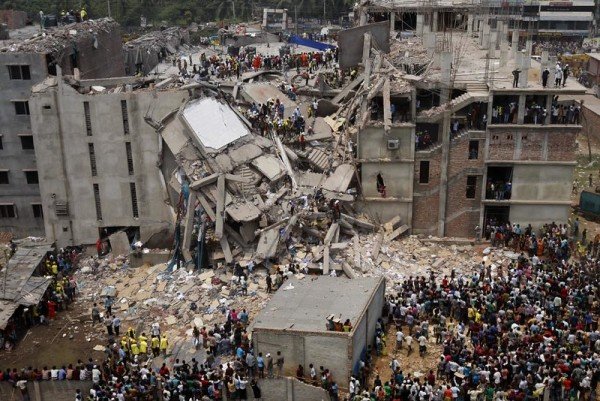
Aerial view of the building following the disaster. Photo credit: Flikr user: rijans
On April 24th 2013, The Rana Plaza in Dhaka, Bangladesh collapsed, leaving approximately 1,133 workers dead and injuring 2,500 more. As the pinnacle of a series of deadly accidents in Bangladesh’s garment industry, this incident received international attention. Since last year, some preventative measures have been taken to ensure worker safety. However, there is still a long way to go before concrete change occurs in this largely unregulated industry.
Bangladesh is the second largest producer of garments in the world. The influx of clothing companies investing in Bangladesh has stimulated an otherwise idle economy and provided many jobs for the population. However, these companies want to pay the lowest prices possible. To obtain the lowest prices for labour and maintain profit, factory owners exploit their workers; the workers are paid minimum wage and work in dangerous environments.
On May 12 2014, the Senate Standing Committee on Human Rights studied the rights of garment workers. The Rana Plaza tragedy was the catalyst for international action, but experts say more needs to be done.
Committee witness Syed Sajjadur Rahman, Professor for the School of International Development and Global studies at the University of Ottawa, gave a compelling testimony. In his expert opinion, there has been little change in Bangladesh’s Garment Industry. He said:
“I have a whole bunch of friends in Bangladesh who own very large textile factories. Before I came here, I had a chat with a whole bunch of them. I said. What’s the change of behaviour? Post-Rana Plaza, have you noticed changes in the behaviour of foreign buyers? The answer is no. All of the foreign buyers basically tell them, ‘I want my stuff at the lowest price I can get it.’ It’s as simple as that.”
According to Professor Rahman, the garment industry is too valuable to Bangladesh’s economy for current legislation to be enforced. As long as international companies continue to demand the lowest possible prices, factory owners will sacrifice worker safety for garment production. However, this issue remains complex due to the poverty stricken working class in Bangladesh.
The Rana Plaza collapse shocked the international community. Many concerned citizens organized campaigns to boycott clothes made in Bangladesh. While such initiatives showed the concern for workers in Bangladesh, these practices would cause more harm than good. The garment industry in Bangladesh provides opportunities to the most desperate individuals who need these jobs to feed their families.
Most garment workers in Bangladesh are poor and uneducated women from rural areas. Since their options of employment are limited, they are easily exploited. Therefore, to reach a solution, the approach must be multi-faceted. To boycott garments made in Bangladesh would devastate their economy and cause further damage to the workers we are trying to protect. Instead, consumers can focus on supporting companies that endorse worker safety as part of their brand image.
Clothing companies who manufacture in Bangladesh faced scrutiny after the Rana Plaza disaster. These companies saw their clothing brands perceived negatively for using factories like the one in the Rana Plaza. Realizing the importance of image, some large global brands have taken measures to protect their workers. Companies like H&M, Topshop, Loblaws and Zara have signed on to The Accord on Fire and Building Safety. The Accord is a legally binding measure that holds corporations accountable for worker safety by mandating the inspection of factories. These large reputable companies have signed on to The Accord, but many other companies remain indifferent to new regulations.
There are many initiatives that support worker safety, but The Accord on Fire and Building Safety is the only legally binding measure. To support the growing initiative for worker safety in Bangladesh, consumers can encourage companies to sign onto the Accord. The Rana Plaza disaster was a heartbreaking example of worker safety issues in Bangladesh and around the world. Through preventative measures supported by consumers and socially responsible companies, this culture of negligence can change. In my next few blogs, I will be further exploring issues of worker safety in Bangladesh, I encourage you to read the posts and voice your feedback on these important issues.
Read Part Two of Senator Jaffer’s Blog Series on Bangladesh’s Garment Workers: The Story of Shapla